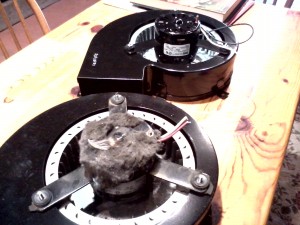MINIMIZING PELLET STOVE ELECTRICAL OR MECHANICAL FAILURE
PELLET STOVE ELECTRICAL OR MECHANICAL FAILURE
It seems elementary to have to say it, but we tend to forget that a pellet stove is a machine first and foremost. They have several moving electrical and mechanical parts which have to work in symphony. They also have sensitive electronics including circuit boards just like computers and televisions. There are a number of reasons why these components could fail. It is said that over 90% of pellet stove malfunctions are due to operator error. You can help prevent failures by performing the required maintenance on your stove and by adding power or surge protection to your stove.
Pellet stoves require considerably less day to day maintenance than a wood stoves do but they are not maintenance free. You do have some basic cleaning chores for your pellet stove every few days such as cleaning the burn pot. In addition, per your owners manual instruction, you should shut down your stove every few weeks or so for a thorough cleaning. This cleaning can take 10 to 30 minutes depending on the model. If this maintenance is ignored then your heat output will diminish and or the stove could possibly shut itself down. In addition, most pellet stoves require a more in depth annual cleaning and if you keep up on your maintenance then your stove should remain relatively trouble free.
My experiences in the field shows that many failures can be prevented. Look at this picture from a recent service call.
In the foreground of the above photo you can see a Harman Accentra Insert room blower which has failed. The grey matter on the motor is a combination of pillow feathers and lint. In the background is a new and clean blower. The customer complaint in this case was a noisy blower. I found that the dust and pillow feathers acted as an insulator and overheated the motor causing the bearings to fail prematurely. The motor was only 4 years old and should have lasted much longer. The blower was never cleaned by the owner. He said he wasn’t aware of it. This demonstrates why the owners manual is so important. Had he read it, he would have been familiar with that blower and could have avoided this expensive failure. Many manufacturers and retailers have resources on line as well for cleaning tips. We have put directions on our web site to help out folks who like to do it themselves. Here is an example in the following link. http://blazinghotstoves.com/wp-content/uploads/2011/08/End-of-Season-Cleaning-of-Accentra-Pellet-Insert-by-Ha
Sometimes the cause of a failure is not as obvious as that blower motor above. However, there are some patterns. For example, when severe weather sets in we see a higher incidence of electrical failures from the pellet stoves. This is due to power spikes and brown outs. These surges can damage solid state electronics like those in your pellet stove. A simple fix for that would be to invest in a high quality surge protector to protect your stove from power spikes. Even better than that is a uninteruptible power supply or UPS. These UPS units will stand guard over your stove and automatically and quickly take the stove off the grid when surges and spikes occur and use its own internal battery and inverter to power your stove until power is restored or its battery dies. The particular product below should be able to power your stove for at least 1/2 hour. Check out the link.
http://www.tripplite.com/en/products/model.cfm?txtSeriesID=743&txtModelID=4147
There are plenty of UPS choices out there, some with more powerful batteries for example, so do your research. Some stove companies such as Harman Stoves make a battery back up for their pellet stoves. Theirs sells for around $600 not including batteries. For the money I feel there are better choices though. For that amount you can buy an inverter style generator that will be more versatile in the long run for extended power outages. However, for short term outages and for component protection the UPS is your best choice.
The key here is clean power when considering a generator.






















